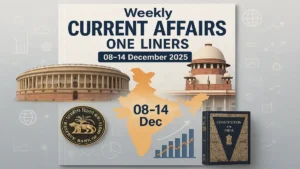RBI Foundation Day 2023
The Reserve Bank of India (RBI) was established on April 1, 1935, in accordance with the provisions of the Reserve Bank of India Act, 1934. The Central Office of the RBI, initially set up in Kolkata, was permanently moved to Mumbai in 1937. Sir Osborne Smith the first Governor of the Bank. The Bank was constituted as a shareholders’ bank. The RBI is the central bank of India and is responsible for regulating the country’s monetary and credit system. It is also responsible for issuing currency and managing the country’s foreign exchange reserves. The RBI works closely with the government of India to formulate and implement monetary and fiscal policies that promote economic growth and stability. It was set up as a private shareholder’s bank with a capital of Rs. 5 crores.
Buy Prime Test Series for all Banking, SSC, Insurance & other exams
The Reserve Bank of India (RBI) performs various functions, some of which are as follows:
- Formulating and implementing monetary policy: The RBI is responsible for formulating and implementing monetary policy in India, with the aim of maintaining price stability while ensuring adequate credit flow to the productive sectors of the economy.
- Regulating and supervising banks and financial institutions: The RBI regulates and supervises banks and financial institutions in India to ensure their stability and soundness.
- Issuing and managing currency: The RBI is responsible for the issuance and management of currency in India.
- Managing foreign exchange reserves: The RBI manages India’s foreign exchange reserves and intervenes in the foreign exchange market to maintain stability in the value of the rupee.
- Acting as a banker to the government: The RBI acts as a banker and advisor to the central and state governments in India, managing their accounts and providing them with credit and other banking services.
- Conducting research and analysis: The RBI conducts research and analysis on various aspects of the economy, including banking and financial systems, monetary policy, and economic development.
- Developing and regulating payment and settlement systems: The RBI develops and regulates payment and settlement systems in India, including electronic fund transfer systems, cheque clearing systems, and other payment mechanisms.
- Promoting financial inclusion: The RBI works to promote financial inclusion and ensure that banking and financial services are accessible to all sections of society.
Here are some important dates in the history of the Reserve Bank of India:
| Important Year | History of the Reserve Bank of India |
|---|---|
| 1935 | Establishment of the Reserve Bank of India under the Reserve Bank of India Act, 1934 |
| 1937 | The Central Office of the RBI, initially set up in Kolkata, was permanently moved to Mumbai in 1937. |
| 1949 | Nationalization of the Reserve Bank of India |
| 1950 | Introduction of a new system of note issue |
| 1951 | Introduction of a system of credit control |
| 1969 | Given additional powers to regulate the credit system with nationalization of 14 major banks |
| 1971 | Declaration of the RBI as the regulator of the Indian money market |
| 1985 | Establishment of the Deposit Insurance and Credit Guarantee Corporation |
| 1991 | Implementation of economic reforms to liberalize the Indian economy |
| 1994 | Introduction of the system of minimum capital requirements for banks |
| 1997 | Becoming the regulator of the entire financial system in India |
| 2016 | Introduction of demonetization of Rs. 500 and Rs. 1,000 banknotes |
| 2018 | Introduction of a new framework for resolving stressed assets in the banking system |
| 2020 | Implementation of a 3-month moratorium on all term loans due to COVID-19 pandemic |
| 2021 | Announcement of the issuance of digital currency, also known as Central Bank Digital Currency (CBDC), in phases |
Here is a list of all RBI Governors until the present day:
| Number | Name | Term |
|---|---|---|
| 1 | Sir Osborne Smith | 1935-1937 |
| 2 | Sir James Braid Taylor | 1937-1943 |
| 3 | Sir C. D. Deshmukh | 1943-1949 |
| 4 | Sir Benegal Rama Rau | 1949-1957 |
| 5 | K. G. Ambegaonkar | 1957-1957 |
| 6 | H. V. R. Iyengar | 1957-1962 |
| 7 | P. C. Bhattacharya | 1962-1967 |
| 8 | L. K. Jha | 1967-1970 |
| 9 | B. N. Adarkar | 1970-1970 |
| 10 | S. Jagannathan | 1970-1975 |
| 11 | N. C. Sen Gupta | 1975-1975 |
| 12 | K. R. Puri | 1975-1977 |
| 13 | M. Narasimham | 1977-1977 |
| 14 | I. G. Patel | 1977-1982 |
| 15 | Dr. Manmohan Singh | 1982-1985 |
| 16 | A Ghosh | 1985-1985 |
| 17 | R. N. Malhotra | 1985-1990 |
| 18 | S. Venkitaramanan | 1990-1992 |
| 19 | C. Rangarajan | 1992-1997 |
| 20 | Bimal Jalan | 1997-2003 |
| 21 | Y. V. Reddy | 2003-2008 |
| 22 | D. Subbarao | 2008-2013 |
| 23 | Raghuram Rajan | 2013-2016 |
| 24 | Urjit Patel | 2016-2018 |
| 25 | Shaktikanta Das | 2018-present |
Find More News Related to Banking




 Weekly Current Affairs One Liners 08th t...
Weekly Current Affairs One Liners 08th t...
 Which Indian City is Known as the Footwe...
Which Indian City is Known as the Footwe...
 Which Desert is known as the Cold Desert...
Which Desert is known as the Cold Desert...







